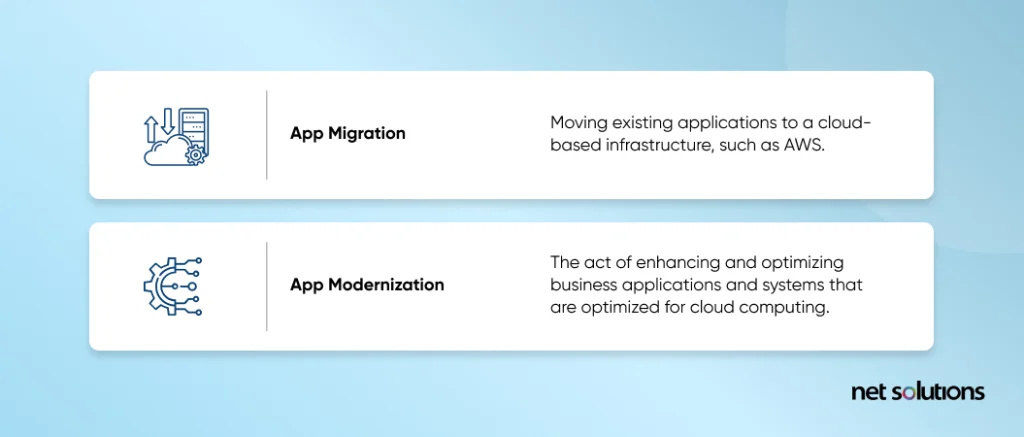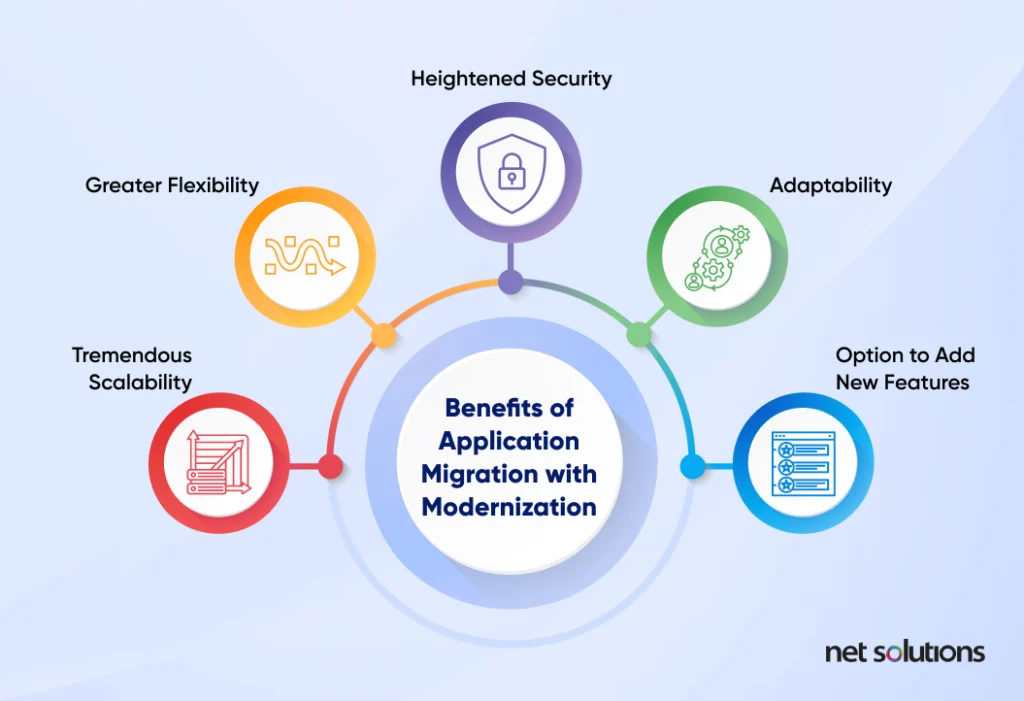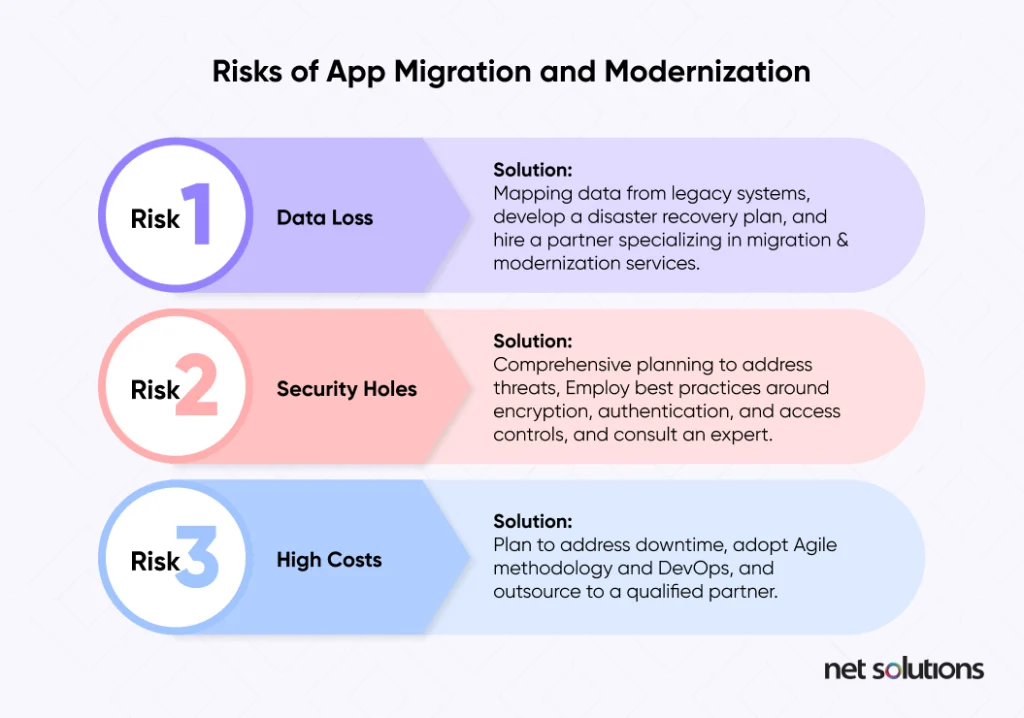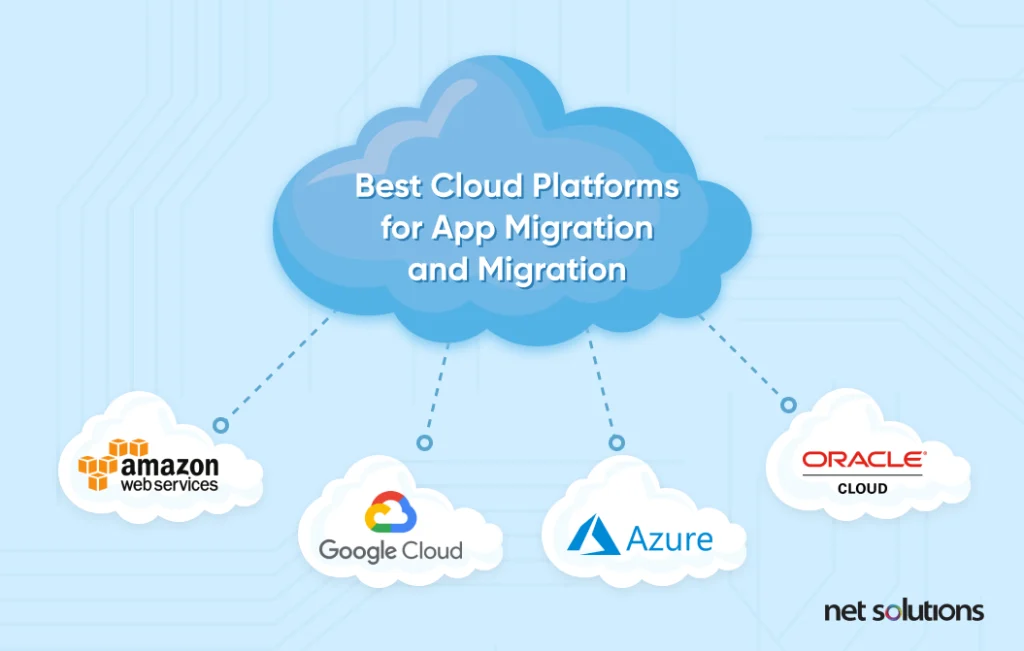Application migration and modernization can seem daunting, especially for an internal IT team that doesn’t perform these tasks regularly.
How do you plan a coherent strategy built around the benefits you want to achieve? How do you reduce risks of data loss, security gaps, and runaway budgets? What managed service cloud provider should you use?
We’ve put together this short guide to answer these questions and point you in the right direction so you can reap all the rewards of a successful cloud migration and app modernization initiative.
What Is Cloud Migration?
Cloud migration is moving software systems and data to a cloud infrastructure to take advantage of the speed, flexibility, and power that digital transformation offers.
Cloud migration can take several forms, from simply moving existing software to the cloud to completely rewriting underlying code to turn legacy systems into modern applications.
Three common approaches to cloud migration include lift-and-shift, replatforming, and refactoring. Here’s a brief description of each.
- Lift-and-shift: Also known as rehosting, this approach involves moving applications to the cloud without changing the underlying code. That might mean creating an API layer around the software so it interacts with more modern apps.
- Replatforming: Taking things further than a rehost, replatforming configures legacy applications to access some of the benefits of cloud-native apps without completely rewriting the code.
- Refactoring: This is the most comprehensive form of cloud migration. It involves installing entirely new cloud-native apps and using a microservices architecture to take advantage of everything cloud environments offer.
Each approach has advantages and disadvantages, and evaluating the ROI associated with each method is essential.
For example, lift-and-shifts are less expensive, all things being equal, but they don’t offer the full power of cloud computing. Refactoring may cost you more upfront, but it can often prove more cost-effective in the long run due to the cost savings that come with digital transformation.
Application migration vs. application modernization
Cloud migration is essential to application modernization since modern apps owe their capabilities to cloud computing, but it’s important not to confuse the two. Application and cloud migration are two different things.
App modernization describes enhancing and optimizing business applications and systems, while app migration simply means moving existing applications to the cloud.
Naturally, app modernization involves app migration if you’re starting with a monolithic infrastructure and moving to a serverless (i.e., cloud-based) environment, but they’re not the same. Using the correct terminology is essential to building a business case for app modernization and communicating value to stakeholders.

Benefits of Application
Migration with Modernization
App migration is almost always part of an app modernization journey because modern apps thrive in a cloud-based environment.
Modern apps are designed to function well with cloud services, from Kubernetes containerization to headless architecture that allows you to use the back end of an app to serve multiple front-end services. Modern apps provide countless benefits that cannot be achieved through on-premise servers.

The benefits of app migration with modernization include:
- Tremendous scalability to handle large fluctuations in traffic and complex workloads,
making it easier to grow a business without incurring slowdowns that frustrate customers and
impact productivity - Greater flexibility to handle the rise and fall of usage, thanks to the pay-as-you-go
models offered by managed cloud services like Amazon
Web Services(AWS) - Heightened security that legacy applications often can’t deliver, especially if
providers have stopped creating updates for their legacy software - Adaptability to connect with modern systems, seamlessly working with them to achieve
new functionality. - Option to add new features easily, thanks to the flexible architecture of
cloud-based apps
Simply put, engaging in a modernization effort is unthinkable without migrating
at least some of your applications to the cloud. You might choose a hybrid cloud model that
keeps some applications within on-premises servers while migrating others to the cloud.
Also, you might create API layers to allow some legacy apps to interact
with modern apps on the cloud. However, it’s difficult to conceive of a cloud journey that
doesn’t involve a healthy dose of modernization, as the need to upgrade to a cloud-based system
is a significant app
modernization driver.
Risks of App Migration and Modernization
App migration is a necessary element of digital
optimization, but as with any significant technology change, it comes with risks.
Understanding common risks and creating a mitigation plan is essential when building your app
migration strategy.
Three common risks worth understanding and assessing are:
- Data loss when transitioning to new infrastructure and transferring data centers
- Security holes created when adopting new, cloud-based technology
- High costs that could force a project to go over budget
Each of these costs can be mitigated through proper planning and expert
council. Working with a partner with experience with app modernization and migration—who knows
how to use the right app
modernization tools—adds tremendous value.

Data loss
Failure to properly migrate data from a server to a cloud-based system
can result in data loss, and there are several reasons this might occur. One major cause of data
loss is that teams must document their data sources before transitioning.
How to mitigate the risks of data loss:
Mapping data from legacy systems to the new software is key to proper migration
and should be listed in your migration and modernization roadmap. Also, develop a disaster
recovery plan to address the worst-case scenario.
You can also hire a partner specializing in migration and modernization services since in-house employees may need to gain the background and experience to perform flawless synchronization.
Security risks
Modern apps and systems tend to be far more secure for several reasons
we’ve covered above. That said, you will face cybersecurity risks every time you transition from
one infrastructure to another.
Security risks arise during app migration and modernization because new systems
have different vulnerabilities. If you don’t have security experts on staff, assessing those
threats and properly mitigating them might be difficult.
How to mitigate security risks:
Build a comprehensive plan to address potential security vulnerabilities due to
the transition. This may include insecure APIs, internal threats, and data transfer
vulnerabilities.
Employ best practices surrounding encryption, authentication, and access
controls to reduce security risks. And don’t hesitate to consult an expert if your team doesn’t
have the internal expertise required! The costs of a security breach will likely outweigh the
price you’d pay for proper guidance, especially considering the impact on your brand’s
reputation.
High cost and going over budget
App modernization and migration often go well over budget for various
reasons. A few things that lead to high costs and runaway budgets include:
- Excess downtime due to improper planning leading to productivity loss and frustrated
customers who abandon your brand - Failure to accurately assess dependencies when refactoring or rearchitecting apps, leading
to interrupted workflows and rework - Inefficient application development processes that slow down development and testing,
leading to missed release deadlines
How to mitigate high costs and runaway budgets:
Proper planning is key to avoiding downtime, and painstakingly documenting
dependencies will help reduce confusion and delays.
Adopting a DeVops approach and implementing application modernization best
practices when building new software is beneficial. Also, adopting an Agile development approach will increase accuracy, speed, and the discovery of novel solutions
that improve the user experience.
Outsourcing to a qualified partner who has handled many app migration and
modernization projects will not only help you avoid many of these challenges—it often comes with
significant cost savings compared to using internal resources.
That’s because internal hiring comes with hidden costs (e.g., payroll
taxes, benefits, hiring costs), and outsourcing to partners in countries with lower costs allows
you to benefit from lower offshore software development rates.
Best Cloud Platforms for App
Migration and Modernization
You’ve got several choices when you use a managed service to host your modern apps on the cloud. Amazon Web Services (AWS) is the largest and most well-known provider, but there are other viable competitors, each with its pros and cons.
You’ll notice that the top cloud providers are often associated with big names (Amazon, Microsoft, etc.), and that’s not surprising. It takes massive infrastructure to handle cloud computing for the world’s top enterprises.
Let’s explore four of the top cloud providers, along with their strengths and weaknesses.

Amazon Web Services (AWS)
AWS is the undisputed leader in cloud infrastructure, and it pioneered the pay-as-you-go model that makes cloud computing so flexible and scalable.
AWS Pros:
- Vast reach
- Top-notch tools, analytics, and security features with over 300 instance types
- Extremely user-friendly and intuitive
AWS Cons:
- Higher price tag than some competitors
- Transitioning from AWS to a competitor can be challenging once you get used to using their proprietary APIs and data storage features
Google Cloud Platform (GCP)
GCP offers very similar services to AWS and other leaders, and they’re constantly adding new features thanks to Google’s forward-thinking approach to improving all its products.
GCP Pros:
- Affordable pricing for data use
- Innovative features that integrate identity security, Artificial Intelligence (AI), and Machine Learning (ML)
GCP Cons:
- While pricing for data use is affordable, support fees can be costly
- Some users report finding the interface confusing
Microsoft Azure
Another top-rated cloud service, Microsoft Azure, offers a broad range of products and services, from databases to networking.
Microsoft Azure Pros:
- Innovative features not always found in other services
- Access to all of Microsoft’s previous products
- Cognitive services (AI) that are arguably as impressive as Google’s offerings
Microsoft Azure Cons:
- Complex interface (due to its vast offerings)
- Additional fees that come with data transfers
- Some users complain of poor customer support
Oracle Cloud
Oracle Corporation offers its cloud computing solution, Oracle Cloud, which provides storage, networking, DNS monitoring, data management, and database services.
Oracle Cloud Pros:
- Users report that scalability and resource provisioning comes easily with Oracle
- Oracle offers advanced automation services built to impress
- Excellent for high-end users with significant resources interested in tapping into a wide range of features and functionality
Oracle Cloud Cons:
- Integrating Oracle with other tools can be difficult in a multi-cloud environment
- Some users suggest that Oracle Cloud has a steeper learning curve compared to other platforms, especially AWS
- Introductory users and smaller customers may find better solutions with other providers
How to Choose the Right
Migration and Modernization Partner
Many companies hire an outsourcing partner to help with application
migration and modernization. Doing so can save money and ensure a smooth transition—assuming you
choose the right partner.
When exploring potential partners to support your modernization efforts, look
for someone with a proven track record who understands the latest app modernization trends.
Do they have case studies and testimonials that demonstrate their work in enterprise app modernization? Don’t simply choose a
software development team; work with someone with vast
experience with modernization and migration.
Also, be sure to choose a partner that handles every aspect of modernization
and migration: Project management, development, QA testing,
migration, and deployment.
Even if you only plan to outsource a portion of your migration or
modernization, full-service firms understand how to navigate challenges from start to finish,
and they can help guide you if you get stuck.
Make Your Application Modernization a Success
Net Solutions is a full-service software development firm with over three decades of experience designing, developing, testing, and deploying software for large enterprises worldwide.
Our business analysts and project managers can handle every aspect of your app modernization and migration projects, just as we did for leaders like Euro Car Parts and American Golf.
Schedule an appointment with one of our specialists to learn how we can help you build a successful, cost-effective modernization and migration initiative.
SHARE THIS POST
Table of Contents
Related Services
Related Resources
- A Framework-based Approach for App Assessment
- App Modernization Benefits To Boost Your ROI and Future-Proof Your Business
- 11 Top Application Modernization Best Practices in 2025
- Building a Winning Application Modernization Business Case
- Legacy Application Modernization Case Studies & Success Stories
- Solving the Toughest Application Modernization Challenges
- Cloud-Native Application Modernization: Benefits & Strategies
- 8 Core Application Modernization Drivers
- Enterprise Application Modernization: Complete Guide [2025]
- Lift and Shift: The Modernization Formula for Legacy Apps
- Application Modernization and Optimization: A Complete Guide
- A Practical Approach to Application Rationalization: A CIO's Guide to Managing Complexity and Reducing Costs
- What is Replatforming? A Beginner's Guide to Upgrading Your Technology Stack
- 7 Steps to Build an Effective Application Modernization Roadmap
- Application Modernization Services Market: Comprehensive Analysis
- A Step by Step Guide to Application Modernization Strategy
- Explore the Best Application Modernization Tools and Resources
- 13 App Modernization Trends That Can Support and Optimize Your App Modernization Strategy


